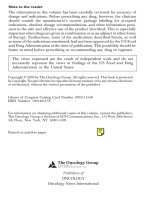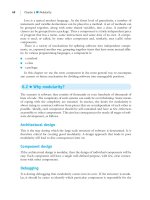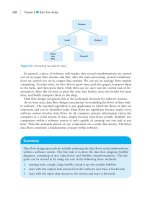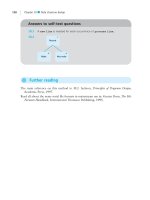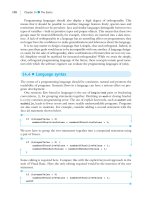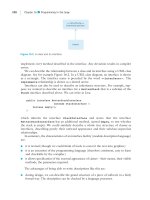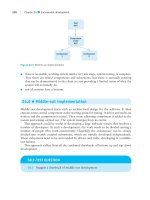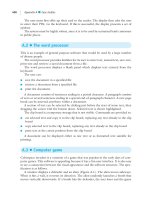Staged diabetes management a systematic approach - part 10 pps
Bạn đang xem bản rút gọn của tài liệu. Xem và tải ngay bản đầy đủ của tài liệu tại đây (235.83 KB, 41 trang )
392 APPENDIX
Check all that apply
7
9. At which point are patients referred for diabetes education?
Who provides diabetes education?
CDE CHR NP/PA Pharm RD RN
Newly Diagnosed type 1
Newly Diagnosed type 2
Type 1 Continuing Education
Type 2 Continuing Education
Impaired Glucose Tolerance
Inpatient
Gestational Diabetes
At Onset of Complications
Pre-conception Counseling
Other
SECTION FOUR: DIABETES EDUCATION SERVICES
1. Do you have a diabetes education curriculum in place in your facility? Yes No.
1. If yes, please describe or attach summary.
2. What diabetes patient education materials do you use?:
ADA Drug Co IDC
1 IHS In House Ministry of Health Other
Figure A.1 (continued)
APPENDIX 393
SECTION FIVE: SYSTEM ASSESSMENT
1. Is there a diabetes committee or team?
Yes No
Chairperson: ______________________________________________________
Members: (by discipline and role)
_______________________________________________________________
_______________________________________________________________
_______________________________________________________________
_______________________________________________________________
_______________________________________________________________
_______________________________________________________________
Will this committee/team be responsible for the implementation of SDM?
2. How will you evaluate success of the SDM program?
______________________________________________________________
______________________________________________________________
a) What process/outcome inidcators will you use? ______________________
b) How often will you measure outcomes? _____________________________
3. Are you currently auditing diabetes care?
No
8
Yes
Yes No
Figure A.1 (continued)
394 APPENDIX
What strengths does your community bring to the diabetes program?
________________________________________________________________
________________________________________________________________
Do you have the following processes to enhance your diabetes care in place?
How will you involve/inform others of the SDM program, its content and
implementation process
5.
Medical staff and employees:
__________________________________________
Health care professionals outside the facility:
______________________________
Patients and their families: _____________________________________
Community and/or community agencies: ____________________________
a.
b.
c.
d.
6.
7. What barriers to improved diabetes care do you have, or expect to experience?
________________________________________________________________
4.
9
Yes No Comments
Diabetes Flowsheet on chart
Case Reviews/Grand Rounds
Diabetes Support Group(s)
Patient Satisfaction Survey
Rapid HbA
1c
available at time
of patient visit
Foot Care Clinic
Community Awareness
Program
Figure A.1 (continued)
APPENDIX 395
8.
What questions do you have to assist you with the Site Preparation or training for SDM?
_____________________________________________________________________
_____________________________________________________________________
_____________________________________________________________________
Thank you for your assistance.
10
Figure A.1 (continued)
396 APPENDIX
1. Site Name ________________________________
2. Abstraction Date:(mm/dd/yy) ________________________________
3. Abstractor Name: _________________________________
4. Abstractor Title: _________________________________
5. Patient Gender: 1 ؍ Female 2 ؍ Male
6. Patient Date of Birth:(mm/dd/yy) ________________________________
7. Pre-Diabetes:
Type of glucose abnormality diagnosed
1 ؍ Impaired Glucose Tolerance
2 ؍ Impaired Fasting Glucose
3 ؍ Other
8. Diabetes Type:
0 ؍ Not documented
1 ؍ Type 1 Diabetes
2 ؍ Type 2 Diabetes
3 ؍ Gestational Diabetes
4 ؍ Prior Gestational Diabetes
5 ؍ Other
9. Year Diabetes Diagnosed: _________________________________
10. Race:
1 ؍ Asian
2 ؍ American Indian/Alaska Native
3 ؍ Black/African-American
4 ؍ Native Hawaiian/
Other Pacific Islander
5 ؍ White
6 ؍ Other
7 ؍ Unknown
11. Ethnicity:
Does patient self-identify as Spanish, Hispanic, or Latino?
1 ؍ No
2 ؍ Yes
12. Visit Date: (mm/dd/yy) _______________________________
13. Blood Pressure Date: (mm/dd/yy) _______________________________
14. Most Recent Blood Pressure Systolic _________________________________:
15. Most Recent Blood Pressure Diastolic _________________________________:
16. Most Recent HbA
1c
Date:(mm/dd/yy) ________________________________
17. Most Recent HbA
1c
Value: _______________________________
18. HbA
1c
Lab Normal Range: ______________
19. Total Serum Cholesterol Date: (mm/dd/yy) _______________________________
20. Total Serum Cholesterol Value: ________________________________________________________________
21. LDL Date: (mm/dd/yy) _______________________________
22. LDL Value: _______________________________
SDM Patient Chart Audit Form
Figure A.2 SDM patient chart audit form
APPENDIX 397
23. HDL Date: (mm/dd/yy) _______________________________
24. HDL Value: ________________________________
25. Serum Triglyceride Value: (mm/dd/yy) _______________________________
26. Serum Triglyceride Value: _________________________________
27. Gross Protein Present:
0 ؍ Not documented
1 ؍ Yes, or previously diagnosed
OR
28. Microalbumin Test Date (mm/dd/yy) ___________________________
OR
29. Urine Albumin Creatinine Ratio Date (mm/dd/yy) ________________________________
AND
30. Urine Albumin Creatinine Ratio (mg/g): ________________________________
31. Self-Management Education:
0 ؍ Not documented
1 ؍ Yes
32. Nutritional Education:
0 ؍ Not documented
1 ؍ Yes
33. Self-Monitoring Blood Glucose:
0 ؍ Not documented
1 ؍ Yes
34. Foot Exam Date: (mm/dd/yy) _______________________________
35. Tobacco Status Documented:
1 ؍ Not documented
3 ؍ Previous tobacco user
2 ؍ Yes, documented in chart
36. If smoker, was referral for Tobacco Cessation made?:
0 ؍ Not documented
1 ؍ Yes
37. Retinal Exam Date: (mm/dd/yy) _______________________________
38. Metabolic syndrome: is patient diagnosed with any type of Metabolic Syndrome in addition
to the above diabetes types?
1 ؍ No 2 ؍ Yes
Figure A.2 (continued)
398 APPENDIX
Set short- and long-term goals (weight control, exercise, food plan, medications, monitoring)
Determine SMBG and HbA
1c
targets
Record current medications
Address lifestyle changes such as activity level and smoking cessation
Educate about preventive care (foot, eye, dental)
Plan contraception and pregnancy with women of childbearing age
Refer patient to registered dietitian for nutrition recommendations (exercise plan) and instruction
Refer patient to diabetes educator for self-management training, BG and urine ketone monitoring
and record-keeping instructions
Plan follow-up schedule with patient
Refer patient for special services as necessary
Medical History
Symptoms/laboratory tests at diagnosis
Previous and current diabetes therapy and control (SMBG and HbA
1c
)
Weight history/especially previous diets
Nutrition and exercise pattern assessment
Medications: assess those that may affect BG (b -blockers, steroids, thiazides)
Growth and development in children and adolescents
Acute or chronic complications including hypoglycemia/hyperglycemia; neuropathy; sexual
dysfunction; retinopathy; nephropathy; foot problems; cardiovascular disease; gastrointestinal
symptoms
Prior or current infections including skin, dental, genitourinary
History of other conditions, including endocrine and eating disorders
Smoking and/or alcohol use
Lifestyle, cultural, psychosocial, abuse, occupational, and economic issues
Previous education about diabetes
•
•
•
•
•
•
•
•
•
•
•
•
Physical Exam
Determine body mass index (BMI ϭ weight/height
2
ϭ kg/m
2
)
BP (sitting and standing)
Examinations: funduscopic; dental; thyroid; cardiovascular; abdominal; neuro/vascular; feet; insulin
injection sites
Growth and development in children (plot on growth charts)
Sexual maturation in children
•
•
•
•
•
Laboratory Evaluation
Fasting (preferred) or casual plasma glucose, if there is a question as to the validity of SMBG results
or for meter quality assuarance
Hemoglobin A
1c
(HbA
1c
)
Fasting lipid profile within 6 months of diagnosis
Urinalysis (urine culture if sediment)
Urine microalbumin (timed or random albumin/creatinine ratio) if dip stick negative for proteinuria;
after 5 years of duration in postpubertal type 1; at diagnosis and then annually in type 2
Serum creatinine in adults; in children if proteinuria present
Thyroid functions in all type 1, in type 2 when thyroid disease is suspected
Other lab assessments as indicated by history (chem profile, CBC)
EKG (adults)
Management Plan
•
•
•
•
•
•
•
•
•
•
•
•
•
•
•
•
•
•
•
Figure A.3 Medical Visit/Initial DecisionPath
APPENDIX 399
Follow-up Visit
Every 1–2 months during adjust phase; every 3–4 months during maintain phase
Interim History
Note current stage (food plan, oral agent, etc., particularly self-adjustment of insulin/oral agent)
Review current medications and illnesses
Review SMBG and HbA
1c
targets
Discuss episodes of hypoglycemia/hyperglycemia (frequency, cause, severity, symptoms, treatment)
Address presence of intercurrent illness/ketonuria
Assess nutrition; exercise; lifestyle changes; psychosocial issues; complications
Evaluate patient’s adherence issues
Assess sexual activity beginning with puberty
Birth control/pregnancy planning for women of childbearing age
Review record book
Assess frequency of monitoring; SMBG ranges; patterns of hypoglycemia/hyperglycemia; validate
meter accuracy annually; response to exercise; illness
If memory meter used, compare with record book or download into computer for analysis
•
•
•
•
•
•
•
•
•
•
•
•
Physical Exam
Determine body mass index (BMI ϭ weight/height
2
ϭ kg/m
2
)
BP (sitting and standing)
Examinations: funduscopic; dental; thyroid; cardiac; abdominal; neuro/vascular; feet; injection sites
for patients on insulin
Growth and development in children (plot on growth charts)
Sexual maturation in children
Examine previous abnormal findings
•
•
•
•
•
•
Laboratory Evaluation
Fasting (preferred) or casual plasma glucose, if there is a question as to the validity of SMBG results
or for meter quality assurance
HbA
1c
•
•
Management Plan
Refer patient to diabetes educator and/or regisitered dietitian for review of self-management and/or
medical nutrition therapy as indicated
Consult with specialists as indicated (ophthalmologist, nephrologist, neurologist, podiatrist)
Yearly Check-Up
•
•
Complete eye examination with dilation by ophthalmologist: annually after 5 years duration in
post-pubertal type 1; at diagnosis and then annually in type 2
Lipid profile: every 5 years if normal; annually if abnormal
Albuminuria: each visit
Urine microalbumin (time or random albumin/creatinine ratio) if dip stick negative for proteinuria:
after 5 years duration in postpubertal type 1; at diagnosis and then annually in type 2
Thyroid: age Ͻ18 if growth problems, enlarged thyroid, or symptoms; age у18 if suspected problem s
EKG: all adults
Foot examination (pulses, nerves and inspection)
•
•
•
•
•
•
•
Figure A.4 Medical Visit/Follow-up DecisionPath
400 APPENDIX
Weight (lb)
Height
130 135 140 145 150 155 160 165 170 175 180 185 190 195 200 205 210 215 220 225 230 235 240 245 250 255 260 265 270 275 280 285 290 295 300 305
25
25
24
23
22
22
21
20
20
19
19
18
18
17
17
16
16
26
26
25
24
23
22
22
21
21
20
19
19
18
18
17
17
16
27
26
26
25
24
23
23
22
21
21
20
20
19
18
18
17
17
28
27
27
26
25
24
23
23
22
21
21
20
20
19
19
18
18
29
28
27
27
26
25
24
23
23
22
22
21
20
20
19
19
18
30
29
28
27
27
26
25
24
24
23
22
22
21
20
20
19
19
31
30
29
28
27
27
26
25
24
24
23
22
22
21
21
20
19
32
31
30
29
28
27
27
26
25
24
24
23
22
22
21
21
20
33
32
31
30
29
28
27
27
26
25
24
24
23
22
22
21
21
34
33
32
31
30
29
28
27
27
26
25
24
24
23
22
22
21
35
34
33
32
31
30
29
28
27
27
26
25
24
24
23
22
22
36
35
34
33
32
31
30
29
28
27
27
26
25
24
24
23
23
37
36
35
34
33
32
31
30
29
28
27
26
26
25
24
24
23
38
37
36
35
33
32
31
31
30
29
28
27
26
26
25
24
24
39
38
37
35
34
33
32
31
30
30
29
28
27
26
26
25
24
40
39
37
36
35
34
33
32
31
30
29
29
28
27
26
25
25
41
40
38
37
36
35
34
33
32
31
30
29
28
28
27
26
26
42
41
39
38
37
36
35
34
33
32
31
30
29
28
28
27
26
43
42
40
39
38
37
36
34
33
32
32
31
30
29
28
27
27
44
43
41
40
39
37
36
35
34
33
32
31
31
30
29
28
27
45
43
42
41
39
38
37
36
35
34
33
32
31
30
30
29
28
46
44
43
42
40
39
38
37
36
35
34
33
32
31
30
29
29
47
45
44
43
41
40
39
38
36
35
34
33
33
32
31
30
29
48
46
45
43
42
41
40
38
37
36
35
34
33
32
31
31
30
49
47
46
44
43
42
40
39
38
37
36
35
34
33
32
31
30
50
48
47
45
44
42
41
40
39
38
37
36
35
34
33
32
31
51
49
48
46
45
43
42
41
40
38
37
36
35
34
33
32
32
52
50
48
47
45
44
43
42
40
39
38
37
36
35
34
33
32
53
51
49
48
46
45
44
42
41
40
39
38
36
36
35
34
33
54
52
50
49
47
46
44
43
42
41
39
38
37
36
35
34
33
55
53
51
50
48
47
45
44
43
41
40
39
38
37
36
35
34
56
54
52
50
49
47
46
45
43
42
41
40
39
38
37
36
35
57
55
53
51
50
48
47
45
44
43
42
40
39
38
37
36
35
58
56
54
52
51
49
48
46
45
44
42
41
40
39
38
37
36
59
57
55
53
51
50
48
47
46
44
43
42
41
40
39
37
37
60
58
56
54
52
51
49
48
46
45
44
43
41
40
39
38
37
5'0"
5'1"
5'2"
5'3"
5'4"
5'5"
5'6"
5'7"
5'8"
5'9"
5'10"
5'11"
6'0"
6'1"
6'2"
6'3"
6'4"
Patients with BMI Ͼ 25 kg/m
2
have a higher risk of adverse effects on health
BMI is defined as body weight (kg) divided by height squared (m
2
) (BMIϭ kg/m
2
)
1 meter ϭ 39.37 inches, 1 kilogram ϭ 2.2 pounds
Figure A.5 BMI chart
APPENDIX 401
Patient experiencing hypoglycemia
BG Ͻ70 mg/dL (3.9 mmol/L) with symptoms
Is patient unconscious or having a seizure?
NO
Is patient confused or combative,
requiring assistance in treatment?
Patient usually able to self-treat
Eat 15 g carbohydrate
SMBG, if possible, immediately following
treatment
If no response, repeat treatment and continue
SMBG
•
•
•
Follow-up
Assess cause and determine level of hypo-
glycemia; identify individual symptoms; discuss
preventive measures and review annually with
patient and significant others
Sypmtoms
Mild: shaking; sweating; tachycardia; dizziness;
hunger; blurred vision; irritability
Moderate: confusion; tiredness; yawning; poor
coordination; headache; double vision;
combativeness
Occurrence
Most common in type 1 diabetes with variable
glucose levels or on intensive treatment program
In type 2 diabetes, hypoglycemia can occur with
oral hypoglycemic agent, combination therapy,
or insulin
In gestational diabetes, hypoglycemia occurs
rarely and generally only in those treated with
insulin (lower threshold to Ͻ60 mg/dL
[3.3 mmol/L])
•
•
•
•
•
Treatment for Severe Hypoglycemia
Subcutaneous or IM glucagon: ½ cc (0.5 mg) for
age Ͻ5; 1 cc (1.0 mg) for age у5
If glucagon not available, call 911 for emergency
assistance; health professionals may administer
50% D/W; 5–25 cc IV
Follow-up
Assess cause of hypoglycemia; make appropriate
adjustments in treatment plan; report episode to
clinician
Treatment for Moderate Hypoglycemia
Fruit juice or glucose gel (30 g)
If patient refuses or is unable to swallow,
administer subcutaneous or IM glucagon
Treatment for Mild to Moderate Hypoglycemia
(15 g carbohydrate)
3–4 glucose tablets
3 tsp honey
½ cup fruit juice
6 saltine crackers
1 slice bread
1 cup milk
15 g glucose gel
¾ cup regular soda
pop
•
•
•
•
•
•
•
•
If next meal or snack is more than 1 hour away,
eat additional snack of 1 carbohydrate and 1 protein
exchange: If patient is on a-glucosidase inhibitor,
use glucose tabs or milk (not sucrose) to treat
hypoglycemia
NO
YES
YES
Figure A.6 Hypoglycemia/Treatment DecisionPath
402 APPENDIX
Causes of Hypoglycemia
Too much insulin (Ͼ1 U/kg) or oral agent
Delayed meals or too little food
Increase in exercise or activity
Alcohol intake (usually without food)
Concurrent medications such as b-blockers
Stress or psychological cause
•
•
•
•
•
•
Preventive Measures
SMBG routinely (2–4 times/day)
Follow prescribed medical nutrition therapy
Do not delay meals or snacks
Eat extra food or adjust insulin for planned
exercise
Be aware of warning signs and treat promptly
Always carry food to treat hypoglycemia
Anticipate schedule changes
Always eat carbohydrates when consuming
alcohol
Make sure friends, co-workers, teachers, and
room-mates are aware of causes, symptoms
and treatment
Have glucagon available for severe
hypoglycemia; review instructions
periodically; check expiration dates
For Nocturnal Hypoglycemia with Insulin
Therapy
Measure BG before evening snack; if
Ͻ100 mg/dL (5.6 mmol/L) may increase snack
Measure BG at 3
AM; if less than target may
need to adjust insulin, time of administration,
or stage of therapy
Adjust SMBG targets if persistent nocturnal
hypoglycemia
Recommendations
Review SMBG targets and adjust higher
(100–160 mg/dL [5.6–8.9 mmol/L]) if
necessary
Treat earliest symptoms immediately
SMBG at least 4 times/day
Treat any BG Ͻ70 mg/dL (3.9 mmol/L) in
adults; Ͻ80 mg/dL (4.4 mmol/L) in children/
elderly; Ͻ60 mg/dL (3.3 mmol/L) in pregnancy
•
•
•
•
•
•
•
•
•
•
•
•
•
•
•
•
•
Patient previously treated for hypoglycemia
Assess potential cause; consider time of day and
activity when hypoglycemia occurred (occurs
most often before meals, during or after exercise,
and at peak times of insulin action)
Begin preventive measures based on cause
Assess Hypoglycemia Unawareness
Experienced most by type 1 patients; may occur
if BG levels are maintained at or below normal
glucose levels, or with increasing duration of
diabetes; SMBG target may need to be adjusted
higher
Rare in type 2 unless on b-blockers or with
autonomic neuropathy
Rare in gestational diabetes
Occurs over time, due in part to loss in ability
to counterregulate effectively
Follow-Up
Review preventive measures with patient
and significant others annually
•
•
•
•
Figure A.7 Hypoglycemia/Prevention DecisionPath
APPENDIX 403
Type of diabetes (diagnosis data)
Diabetes treatment regimen (medications,
medical nutrition therapy)
Medical history (HTN, lipids, complications)
HbA
1c
/ketones/SMBG data
SMBG/HbA
1c
targets
Prescription for BG testing, if needed
Diabetes education indicated
Obtain Referral Data
•
•
•
•
•
•
Establish Education Plan
Assessment
Height/weight (BMI)/BP/foot exam with
monofilament
Risk factors (family history, obesity, ethnicity,
GDM)
Diabetes knowledge/skills
Psychosocial issues (denial, anxiety,
depression)
Economic/cultural factors
Readiness to learn/barriers to learning
Lifestyle (work, school, food and exercise
habits)
Tobacco/alcohol use
Support systems
Health goals
•
•
•
•
•
•
•
•
•
•
Goals
SMBG/HbA
1c
in target
Achieve self-management knowledge/skills/
behavior (SMBG, medications, nutrition,
exercise)
•
•
Plan
Teach initial education topics
Establish 3 behavior change goals with patient
(exercise, nutrition, medications, monitoring)
•
•
Move to Diabetes Education/Follow-Up
Document and communicate education delivered
and behavior change goals in writing to referral
source
Follow-Up
Education: 2–4 weeks
Diabetes Complications and Treatment
CVD: antihypertensives
Dyslipidemia: lipid-lowering agents
Retinopathy: laser therapy
Nephropathy: nutritional interventions
Neuropathy: pharmacologic agents
Foot Problems: ulcer treatment
Behavior Change Goals
Goals must be specific, reasonable, and
measurable
Establish a time frame and evaluation points
Document goals for the patient record and give
copy to patient
Encourage rewards for progress
•
•
•
•
Figure A.8 Diabetes Education/Initial DecisionPath
404 APPENDIX
Follow-up diabetes education indicated
Obtain Referral Data
Type of diabetes (diagnosis data)
Diabetes treatment regimen (medications,
medical nutrition therapy)
Medical history (HTN, lipids, complications)
HbA
1c
/ketones/SMBG data
SMBG/HbA
1c
targets
Prescription for BG testing, if needed
•
•
•
•
•
•
Perform Assessment
Height/weight (BMI)/BP/foot exam with
monofilament
Self-management knowledge/skills
SMBG records/meter accuracy
Progress toward BG/HbA
1c
goals
Incidence of hypoglycemia/hyperglycemia
Progress on behavior change goals
Patient questions/concerns
•
•
•
•
•
•
•
Are goals being met?
YES
Is any additional education needed?
YES
NO
NO
Summarize progress; document and
communicate in writing to referral source
Follow-Up
Education: annual visits
Diabetes Complications and Treatment
CVD: antihypertensives
Dyslipidemia: lipid-lowering agents
Retinopathy: laser therapy
Nephropathy: nutritional interventions
Neuropathy: pharmacologic agents
Foot Problems: ulcer treatment
Diabetes Education Goals
SMBG/HbA
1c
in target
Achieve self-management knowledge/skills/
behavior (SMBG, medications, nutrition,
exercise)
•
•
Consider addressing adherence issues, updating
education plan, or setting new behavior change
goals; document and communicate education
delivered and new goals in writing to referral
source
Follow-Up
Education: 2–4 weeks
Review specific topics; documents and
communicate education delivered in writing
to referral source
Follow-Up
Education: within 3 months
Figure A.9 Diabetes Education/Follow-up DecisionPath
APPENDIX 405
Initial Visit
Follow-up Visits
General Information
Diabetes pathophysiology (definition and causes of
hyperglycemia, type 1 vs. type 2)
Interaction of food/exercise/medication
Insulin resistance/obesity (type 2)
Target goals (SMBG, HbA
1c
, weight)
Medication administration/adjustment
SMBG technique/record-keeping
Daily schedule (testing, medication, meals, snacks)
Hypoglycemia signs (dizziness, sweating, confusion,
loss of consciousness)
Hyperglycemia signs (fatigue, acetonic, polyuria,
polydipsia, polyphagia)
Prevention/treatment of hypoglycemia/hyperglycemia
Emergency phone numbers
Patient education materials
•
•
•
•
•
•
•
•
•
•
•
•
Add for Insulin Users
Insulin action
Daily injection schedule/site rotation
Insulin injection technique (site, angle, drawing and
mixing)
Insulin storage
Syringe/lancet disposal
Hypoglycemia/glucagon use
Urine ketone monitoring (type 1)
Medical identification
Add for Insulin Pump Users
Pump operation and care
Site care (change site every 24–48 hours)
Use of algorithm for bolus/basal ratio
Record-keeping
•
•
•
•
•
•
•
•
•
•
•
•
General Information
New topics based on assessment
Review first-visit topics/re-educate as needed
Check SMBG skills/meter accuracy
Precautions when driving
Illness management
Benefits/responsibilities of self-care
Added for Insulin Users
Pattern control
Compensatory/anticipatory insulin adjustments
Hypoglycemia unawareness
Review injection technique
Travel/schedule changes and effect on insulin
Added for Insulin Pump Users
Review hypoglycemia signs (dizziness, sweating,
confusion, loss of consciousness)
Unexplained hyperglycemia (causes, recognition,
treatment)
Exercise (insulin adjustments, pump care)
Problem-solving skills
Add as Needed
Foot/skin/dental care
Recognition of complications (numbness, persistent
ulcers, blurry vision, frequent urination)
Healthy lifestyle (weight management, exercise,
tobacco and alcohol use, stress management)
Travel/schedule changes
Sexuality (impotence, contraception, pregnancy
planning)
Psychological adjustments
Community diabetes resources
•
•
•
•
•
•
•
•
•
•
•
•
•
•
•
•
•
•
•
•
•
•
Figure A.10 Diabetes education topics
406 APPENDIX
Nutrition intervention indicated
Obtain Referral Data
Type of diabetes (diagnosis data)
Diabetes treatment regimen (medications,
medical nutrition therapy)
Medical history (HTN, lipids, complications)
HbA
1c
/ketones/SMBG data
SMBG/HbA
1c
targets
Medical clearance for exercise (adults)
•
•
•
•
•
•
Establish Food Plan
Assessment
Food history or 3 day food record (meals,
times, portions)
Nutrition adequacy
Height/weight/BMI
Weight goals/eating disorders
Psychosocial issues (denial, anxiety,
depression)
Economic/cultural factors
Nutrition/diabetes knowledge
Readiness to learn/barriers to learning
Work/school/sports schedules
Exercise (times, duration, types)
Tobacco/alcohol use
Vitamin/mineral supplements
•
•
•
•
•
•
•
•
•
•
•
•
Goals
SMBG/HbA
1c
in target
Achieve desirable body weight (adults)
Normal growth and development (children)
Consistent carbohydrate intake
•
•
•
•
Plan
Establish adequate calories for growth and
development/reasonable body weight
Set meal/snack times
Integrate insulin regimen with medical
nutrition therapy (insulin users)
Set consistent carbohydrate intake
Encourage regular exercise
Establish adequate calories for pregnancy/
lactation/recovery from illness
•
•
•
•
•
•
Move to Nutrition Education/Follow-Up
Document and communicate medical nutrition
therapy and education delivered in writing to
referral source
Follow-Up
Nutrition: within 1 month
Diabetes Complications and Treatment
CVD: antihypertensives
Dyslipidemia: lipid-lowering agents
Retinopathy: laser therapy
Nephropathy: nutritional interventions
Neuropathy: pharmacologic agents
Foot Problems: ulcer treatment
Medical Nutrition Therapy Guidelines
Total fat ϭ 30% total calories; less if obese and
high LDL
Saturated fat Ͻ10% total calories; Ͻ7% with
high LDL
Cholesterol Ͻ300 mg/day
Sodium Ͻ2400 mg/day
Protein reduced to 0.8 g/kg/day (~10% total
calories) if macroalbuminuria
Calories decreased by 10–20% if BMI
Ͼ25 kg/m
2
•
•
•
•
•
•
Calorie Requirements
Adults
Most men/active women: weight (lb) ϫ 15 kcal
Most women/inactive men/most adults Ͼage 55:
weight (lb) ϫ 13 kcal
Inactive women/obese adults/inactive adults
Ͼage 55: weight (lb) ϫ 10 kcal
Children/Method 1
First year: 1000 kcal/year
Ages 1–10: add 100 kcal/year
Age 11–15: boys add 200 kcal/year; girls add
100 kcal/year
Age Ͼ15: Boys add for activity (23 kcal/lb very
active, 18 kcal/lb normal, 16 kcal lb inactive);
girls calculate as adult
Children/Method 2
First year: 1000 kcal
Ages 1–3: add 40 kcal/inch
Age Ͼ3: Boys 125 kcal ϫ age; girls 100 kcal ϫ
age; add up to 20% kcal for activity
Figure A.11 Nutrition Education/Initial DecisionPath
APPENDIX 407
Follow-up nutrition education indicated
Obtain Referral Data
Type of diabetes (diagnosis data)
Diabetes treatment regimen (medications,
medical nutrition therapy)
Medical history (HTN, lipids, complications)
HbA
1c
/ketones/SMBG data
SMBG/HbA
1c
targets
Medical clearance for exercise (adults)
•
•
•
•
•
•
Perform Assessment
Food history or 3 day food record (meals,
times, portions)
Nutrition adequacy/carbohydrate intake
Height/weight/BMI, see BMI Chart
Growth and development (children)
Progress toward weight goal
SMBG records
Progress toward BG/HbA
1c
goals
Incidence of hypoglycemia/hyperglycemia
Work/school/sports schedules
Exercise (times, duration, types)
Psychosocial issues (denial, anxiety,
depression)
Economic/cultural factors
Nutrition/diabetes knowledge
Readiness to learn/barriers to learning
Tobacco/alcohol use
Vitamin/mineral supplements
Patient questions/concerns
•
•
•
•
•
•
•
•
•
•
•
•
•
•
•
•
Are goals being met?
YES
NO
Is any additional education needed?
Summarize progress; document and
communicate in writing to referral source
Follow-Up
Nutrition: annual visits
Diabetes Complications and Treatment
CVD: antihypertensives
Dyslipidemia: lipid-lowering agents
Retinopathy: laser therapy
Nephropathy: nutritional interventions
Neuropathy: pharmacologic agents
Foot Problems: ulcer treatment
Nutrition Education Goals
SMBG/HbA
1c
in target
Achieve desirable body weight (adults)
Normal growth and development (children)
Consistent carbohydrate intake
•
•
•
•
Consider addressing adherence issues, changing
medical nutrition therapy, or changing pharmaco-
logical therapy; update food plan; document and
communicate new food plan and education
delivered in writing to referral source
Follow-Up
Nutrition: 2–4 weeks
Review specific topics; document and
communicate education delivered in writing
to referral source
See Nutrition Education Topics
Follow-Up
Nutrition: within 3 months
NO
YES
Figure A.12 Nutrition Education/Follow-up DecisionPath
408 APPENDIX
Food components (carbohydrate, protein, fat)
Effect of food on BG levels (carbohydrates have
greatest effect)
Portion control (average servings, measuring,
estimating)
Realistic weight goals (achievable, maintainable)
Guidelines for fat intake
Guidelines for exercise
Guidelines for treatment of hypoglycemia
Individualize medical nutrition therapy
Synchronization of insulin with food
Consistency in timing of meals and snacks
Prevention and treatment of hypoglycemia (food or
beverage choices and amounts)
Adjusting food intake/insulin for exercise
Review first visit topics and short-term goals
Carbohydrate counting
Nutrition management during short-term illness
Food nutrition labels/healthy food choices
Use of food with higher sugar content
Reset short-term goals
Food related questions/problem-solving
Pattern control for adjusting insulin/food
Anticipatory insulin adjustments for changes in basic
medical nutrition therapy
Travel/schedule changes; effect on insulin
Review SMBG/food and insulin adjustments
Food/insulin adjustments for short-term illness
Sources of carbohydrate/protein/fat; effects on BG/other
health factors (blood lipids, CHD)
SMBG to problem solve/identify patterns related to
food intake
Adjusting meal times or delayed meals
Travel/schedule changes
Holidays/special occasions; restaurant/fast food choices
Alcohol guidelines/effect on BG
Recipes/menu ideas/cookbooks
Dietetic foods/sweeteners
Exchanges and equivalencies
Behavior modification/problem-solving tips
Vitamin/mineral/nutritional supplements
•
•
•
•
•
•
•
•
•
•
•
•
•
•
•
•
•
•
•
•
•
•
•
•
•
•
•
•
•
•
•
•
•
•
•
General Information Add for Insulin Users
Initial Visit
General Information
Add as Needed
Add for Insulin Users
Follow-up Visits
Figure A.13 Nutrition education topics
APPENDIX 409
Method of meal planning that takes into account only
carbohydrate content of foods
May be used in people with type 1 diabetes, type 2
diabetes, and in pre-gestational and gestational diabetes
Individualize carbohydrate intake for each patient
15 g carbohydrate ϭ 1 carbohydrate choice
1 carbohydrate choice is provided in one serving of
food from the starch, fruit, or milk food exchange lists
“Simple” and “complex” carbohydrate absorption rates
are similar
Emphasize total carbohydrate content of foods, rather
than the source
Carbohydrate is the first and primary nutrient that
affects BG levels
Consistency of carbohydrate intake will promote
consistency in BG control
Serves as a guideline for how much carbohydrate to
consume at meals and snacks
Provides flexibility in food choices
Sugar (sucrose) affects BG levels in a similar way
as other carbohydrate foods
Sugar and foods high in sugar must be counted into
the food plan or substituted for other carbohydrate
Foods that are high in sugar are often high in fat and
low in nutrients, making them a source of “empty
calories”
Sugar and foods high in sugar should not be encour-
aged, rather worked into the food plan appropriately
Potential for weight gain if too many foods high
in fat are consumed
Nutritional inadequacy of the diet if the food plan
is not well balanced with a variety of foods
May be be used to teach people how to make adjustments
in regular or rapid-acting insulin for adding or
subtracting food from their usual food plan
Normally 1 unit bolus insulin for each 15 g of
carbohydrate (or 1 carbohydrate choice)
Add 1 unit of short-acting insulin to cover 1 extra
carbohydrate choice to be eaten at that meal
Subtract 1 unit of short-acting insulin from usual dose if
1 less carbohydrate choice is to be eaten at that meal
Frequent monitoring and diligent record keeping are
required
Typically 3–4 carbohydrate choices at meals and
1–2 choices at snacks
Spread carbohydrate choices throughout the day to
promote BG control
Avoid high-fat foods to prevent possible weight gain
•
•
•
•
•
•
•
•
•
•
•
•
•
•
•
•
•
•
•
•
•
•
•
•
•
For All Patients
General Information Sugar
Considerations
Additional Considerations
Intensive Management Type 2 Diabetes
Figure A.14 Carbohydrate counting
410 APPENDIX
Carbohydrate Servings (15 g carbohydrate; 60–90 calories)
Starch Group
Bagel or English muffin
Bread, slice or roll
Cereal, cooked
Cereal, dry, unsweetened
Corn, cooked
Crackers, snack
Dried beans, cooked
Graham crackers
Hamburger or hot dog bun
Lima beans, cooked
Muffin, small
Pancakes, 4" across
Pasta, cooked
Peas, cooked
Popcorn, plain, unbuttered
Potato, small
Potato, mashed
Rice, cooked
Squash, winter, cooked
Taco shells, 6" across
Tortilla, 6" across
Waffles, 4½" across
Fruit Group
Banana
Berries or melon
Canned fruit in juice or water
Dried fruit
Fresh fruit
Fruit juice
Grapes or cherries
Raisins
Milk Group
Milk, skim or low-fat
Yogurt, low-fat, artificially
sweetened (6–8 oz)
Yogurt, plain, low-fat
(6–8 oz)
Meat and Meat Substitutes Servings (7 g protein; 5 g fat; 50–100 calories)
Meats
Beef, lamb, pork, seafood, ham, veal
Poultry with skin removed
Meats should be baked, broiled, roasted, or grilled
Average serving size is 3 oz
Meat Substitutes
Cottage cheese
Cheese
Egg
Peanut butter
Tuna or salmon packed in water
¼ cup
1 oz
1
2 tbsp
¼ cup
Fat Servings (5 g fat; 45 calories)
Butter
Cream cheese
Cream, table or light
Gravy
Margarine
Mayonnaise
Nuts
Oil
1 tsp
1 tbsp
2 tbsp
2 tbsp
1 tsp
1 tsp
1 tbsp
1 tsp
Peanut butter
Reduced-calorie margarine
Reduced-calorie mayonnaise
Reduced-calorie salad dressing
Salad dressing
Sour cream
Sunflower seeds
2 tsp
1 tbsp
1 tbsp
2 tbsp
1 tbsp
2 tbsp
1 tbsp
1 half or 1 oz
1 or 1 oz
½ cup
¾ cup
½ cup
4–5
½ cup
3 squares
1 half or 1 oz
cup
1
2
½ cup
cup
3 cups
1
½ cup
½ cup
1 cup
2
1
1
2
3
1
3
½ medium
1 cup
½ cup
¼ cup
1 medium
to ½ cup
12 to 15
2 tbsp
1 cup
¾ to 1 cup
¾ to 1 cup
1
3
Excerpted from My Food Plan
© 2003 International Diabetes Center
Figure A.15 Food choices
APPENDIX 411
Exercise assessment indicated
Obtain Referral Data
Obtain Medical Clearance
Obtain Fitness Clearance
Start Exercise/Plan
Type of diabetes
Diabetes treatment regimen (medications,
medical nutrition therapy)
Medical history (HTN, lipids, complications)
HbA
1c
/ketones
SMBG/HbA
1c
targets
Avoid strenuous exercise if BP Ͼ180/100
mmHg; if active proliferative retinopathy or
recent laser therapy; if recent foot disease or no
feeling in extremities (neuropathy)
If HbA
1c
Ͼ6 percentage points above upper
limit of normal, measure change in BG during
test exercise
Perform stress EKG if pre-existing CHD; over
age 40; or over age 30 with Ͼ10 years duration
of diabetes
Medical clearance obtained?
YES
NO
Strength:
Flexibility:
Endurance:
lift 5–10 lb overhead
stretch to reach feet
step test
Fitness clearance obtained?
Does patient understand the role
of exercise in diabetes?
Educate patient about benefits of exercise
Refer to exercise specialist to improve fitness
for exercise
If micro- or macro-vascular disease, refer
accordingly
If BG control problem, adjust medical nutrition
therapy and/or medication to optimize control,
then reassess for exercise
•
•
•
•
•
•
•
•
YES
YES
NO
NO
Figure A.16 Exercise/Assessment
412 APPENDIX
Establish Exercise Plan
Goals
Plan
Follow-Up
Exercise Adjustment Guidelines
Consistent exercise schedule
Include aerobic (jog, swim, bike) and anaerobic
(weight lifting, push ups) exercises
Frequency: 3 times/week
Duration: 30 minutes/session
Intensity: 50–75% maximum heart capacity
(220 – age ϭ 100%)
If obese, expend 700–2000 calories/week
Individualize based on fitness level, age,
weight, personal goals, and medical history
Select type of exercise with patient
Set exercise schedule with patient
Measure, record, and review SMBG before and
20 minutes after exercise
Patient to record type, duration, and intensity
Patient to note any symptoms, i.e., pain,
dizziness, shortness of breath, hypoglycemia
Follow-Up
Each week for 2 weeks
Is exercise plan followed?
Is glycemic control improving?
Document and communicate exercise plan and
education delivered in writing to referral source
Every 4 weeks by telephone for 3 months,
then at every office visit
Assess food plan to make certain patient is not
overeating to compensate for exercise
Review SMBG, pre- and post-exercise, re-set
SMBG targets accordingly
If patient is consistently hyperglycemic 20
minutes after exercise, SMBG at 60 minutes
after exercise and adjust exercise duration and
intensity accordingly
Refer to exercise specialist, if available
Review reasons (physical discomfort, hypo-
glycemia or hyperglycemia, inappropriate type of
exercise); re-educate patient and re-set goals
•
•
•
•
NO
YES
•
•
•
•
•
•
•
•
•
•
•
•
Exercise assessment completed
YES
NO
Figure A.17 Exercise/Plan DecisionPath
APPENDIX 413
Initial Visit
General Information Add for Insulin Users
Food components (carbohydrate, protein, fat)
Effect of food on BG levels (carbohydrates have
greatest effect)
Portion control (average servings, measuring,
estimating)
Realistic weight goals (achievable, maintainable)
Guidelines for fat intake
Guidelines for exercise
Guidelines for treatment of hypoglycemia
Individualize food plan
Synchronization of insulin with food
Consistency in timing of meals and snacks
Prevention and treatment of hypoglycemia (food or
beverage choices and amounts)
Adjusting food intake/insulin for exercise
•
•
•
•
•
•
•
•
•
•
•
•
General Information Add for Insulin Users
Add as Needed
Follow-Up Visits
Review first-visit topics and short-term goals
Carbohydrate counting
Nutrition management during short-term illness
Food nutrition labels/healthy food choices
Use of food with higher sugar content
Reset short-term goals
Food related questions/problem-solving
Pattern control for adjusting insulin/food
Anticipatory insulin adjustments for changes in basic
food plan
Travel/schedule changes; effect on insulin
Review SMBG/food and insulin adjustments
Food/insulin adjustments for short-term illness
Sources of carbohydrate/protein/fat; effects on BG/other
health factors (blood lipids, CHD)
SMBG to problem solve/identify patterns related to food
intake
Adjusting meal times or delayed meals
Travel/schedule changes
Holidays/special occasions; restaurant/fast food choices
Alcohol guidelines/effect on BG
Recipes/menu ideas/cookbooks
Dietetic foods/sweeteners
Exchanges and equivalencies
Behavior modification/problem-solving tips
Vitamin/mineral/nutritional supplements
•
•
•
•
•
•
•
•
•
•
•
•
•
•
•
•
•
•
•
•
•
•
•
Figure A.18 Exercise education topics
414 APPENDIX
YES
Patient with self-management issues
Does patient consistently follow food plan?
Does patient take medication as prescribed?
Does patient consistently perform
SMBG and record results?
Does patient follow exercise program regularly?
Does patient have significant
psychosocial issues?
Follow-Up
Assess self-management at every visit
Follow Food Plan Adherence
Follow Medication Adherence
Follow SMBG Adherence
Follow Exercise Adherence
Follow Psychosocial Assessment
YES
NO
NO
NO
NO
NO
YES
YES
YES
Figure A.19 Diabetes Management Patient Adherence DecisionPath
APPENDIX 415
Patient with food plan adherence issues
Does patient understand the food plan
and its relationship to managing
BG levels, medication effectiveness,
and exercise optimization?
Is patient willing to set
food plan behavior goals?
YES
Set Goals with Patient
Write clear, simple, achievable goals; must be
measurable; include timeline; limit to 3 or fewer
goals at one time
Example: I will drink 1% milk instead of 2% or
whole milk at meals and snacks for the next 2
weeks.
Re-set goals as necessary
Is patient taking an active role in
changing food plan behaviors?
Is patient consistently following food plan?
Follow-Up
Evaluate food plan goals at each visit
Consider referral to diabetes educator or
licensed psychologist for counseling
NO
Assess patient’s ability to
identify problem areas
self-adjust goals and behaviors
take deliberate action to change behaviors
self-monitor behavior change actions
Assist patient with problem solving
•
•
•
•
Re-educate patient; consider referral to diabetes
educator or licensed psychologist for
counseling
Re-educate patient about purpose and importance
of following a food plan; consider referral to
registered dietitian
YES
YES
YES
NO
NO
NO
Figure A.20 Food Plan Adherence DecisionPath
416 APPENDIX
Patient with medication adherence issues
Does patient understand the relationship
between medications (oral agents and/or
insulin) and glycemic control?
Is patient willing to set
medication behavior goals?
Set Goals with Patient
Write clear, simple, achievable goals; must be
measurable; include timeline; limit to 3 or fewer
goals at one time
Example: I will take my oral diabetes
medication tablet as soon as I awake every day
for the next week.
Re-set goals as necessary
Is patient taking an active role in
changing medication behaviors?
Is patient consistently taking
medications as prescribed?
Follow-Up
Evaluate medication behavior goals at each visit
Re-educate patient about importance of accuracy
and timing in taking medications; demonstrate
how to administer insulin, use oral agents, and
test BG; consider referral to diabetes educator
Re-educate patient; consider referral to diabetes
educator or licensed psychologist for
counseling
Assess patient's ability to
identify problem areas
self-adjust goals and behaviors
take deliberate action to change behaviors
self-monitor behavior change actions
Assist patient with problem solving
•
•
•
•
Consider referral to diabetes educator or
licensed psychologist for counseling
NO
YES
YES
YES
YES
NO
NO
NO
Figure A.21 Medication Adherence DecisionPath
